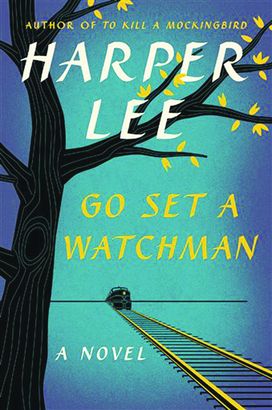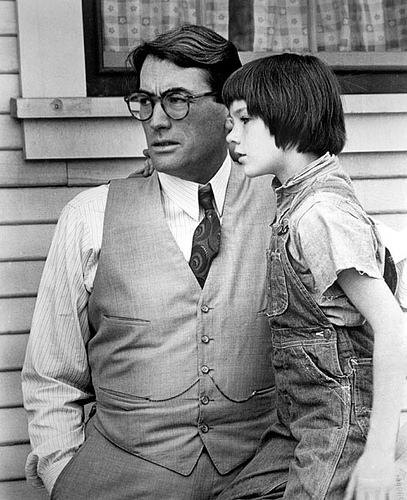 Go Set a Watchman, the unexpected and controversial sequel (of sorts) to Harper Lee’s classic To Kill a Mockingbird isn’t a bad read – I’ll say that up front – if it’s taken with a grain of salt. Maybe you need to tip the salt shaker upside down, pull out the little rubbery stopper, and dump all of the salt out, but still – there are good passages and interesting bits to chew on.
Go Set a Watchman, the unexpected and controversial sequel (of sorts) to Harper Lee’s classic To Kill a Mockingbird isn’t a bad read – I’ll say that up front – if it’s taken with a grain of salt. Maybe you need to tip the salt shaker upside down, pull out the little rubbery stopper, and dump all of the salt out, but still – there are good passages and interesting bits to chew on.
Published July 14 by HarperCollins, the book is being publicized as being a “sequel.” When we first meet Jean Louise Finch (née, Scout), she is traveling by train back to her hometown of Maycomb, Ala., having moved north to New York City. Now in her mid-twenties, she visits home to reconnect with aunt Alexandra, her uncle Jack, a retired doctor and town cuckoo, and her father Atticus, a lawyer and former state legislator. She’s in a flirtmance with her childhood friend and suitor, Henry “Hank” Clinton, who used to live across the street, but now works for her dad. Throughout the course of the novel, Jean Louise must come to terms and heavily weigh her personal and political morals as she desperately tries to understand her father’s new-found attitude toward society and her own feelings about the place where she was born and grew up. A place that is so near and dear to her, yet one she barely identifies with at the same time.
While I doubt many of the negative reviews towards Watchman are overlooking this next fact, I do think that most reviewers aren’t taking it into enough consideration: Watchman was the first draft of Mockingbird. Lee completed Watchman in 1957. Her editor, Tay Hohoff, saw a spark in the writer, but felt that the real story was buried deep within Jean Louise’s childhood flashbacks; she suggested Lee go back and rewrite her story. Alas, Mockingbird was birthed, and the young Scout as we know and love her was fleshed out. So to review Watchman as a “sequel” is flat out wrong and misleading, yet many of the negative reviews don’t seem to really validate this fact as a reason why the work feels plotless, undeveloped, and a bit misguided. (I’m not going to tackle the issue of whether or not Lee wanted Watchman published in the first place, but you can certainly read more about that here and here.)
If your expectations are of Mockingbird proportions, then yes, you are in for a sore disappointment. But as we can’t compare a posthumous Michael Jackson record of unreleased material to, say, Thriller, this sequel first draft should not be reviewed with the same heavy hand. Considering the events surrounding its controversial  publication, there are still great aspects about the story, starting with the fact that we get a snapshot of an adult Jean Louise – and she is everything that Atticus (and we) always hoped she would be. She’s a rare bird, no pun intended, for the book’s time period – the ’50’s. She’s a strong female with her own opinions who refuses to change herself to conform to southern society’s views of how she should be. A once bratty Scout made for a tenacious and praiseworthy adult. She’s grown up, yet continues to learn more about herself and her convictions. She learns that in this life, self-searching truly never ends, even though she may not be aware or ready for what’s to come later in the book’s pages. I loved reading this perspective of her.
publication, there are still great aspects about the story, starting with the fact that we get a snapshot of an adult Jean Louise – and she is everything that Atticus (and we) always hoped she would be. She’s a rare bird, no pun intended, for the book’s time period – the ’50’s. She’s a strong female with her own opinions who refuses to change herself to conform to southern society’s views of how she should be. A once bratty Scout made for a tenacious and praiseworthy adult. She’s grown up, yet continues to learn more about herself and her convictions. She learns that in this life, self-searching truly never ends, even though she may not be aware or ready for what’s to come later in the book’s pages. I loved reading this perspective of her.
Another theme that runs rampant throughout is the notion of “home” – what does it really mean and are we ever ready to confront the past? While building her own character, Jean Louise must also come to terms with Maycomb’s identity, including its societal norms, past and present. And once we’ve grown and moved away…can you ever really go home again? It’s a rites of passage for our protagonist, and reading her navigate these muddy waters was worth the time.
There’s a shocker about brother Jem in Chapter 1 that has people all in a tussle (it won’t be revealed here), and a later development with Atticus drops an even bigger bomb, but given the time, it’s all aligned with the decade’s zeitgeist. It’s far from perfect, yet despite its flaws and rough edges, I still cry foul on reviews that want to belittle the book simply for shattering these perfect images we cherish about Jem and Atticus. But again, I reiterate: the book must be read as a first-draft, and not as a sequel.
Although there is a plethora of opinions floating about, I agree with The Los Angeles Times‘ David L. Ulin who wrote:
“It would be a mistake to read Harper Lee’s Go Set a Watchman as a sequel to her 1960 Pulitzer Prize winning To Kill a Mockingbird…Despite its potential for drama, Lee develops her story through long dialogue sequences that read less like conversation than competing arguments. There is little sense of urgency and key aspects of the narrative — Jean Louise’s naïvete, for one thing, her inability to see Maycomb for what it is — are left largely unresolved. If I’m hesitant to level such a criticism, it’s because, although Go Set a Watchman comes marketed as an autonomous novel, it is most interesting as a literary artifact.”
And a literary artifact it shall remain. With even-keeled expectations, you can enjoy Watchman for what it is. And if not, well…blame the misleading marketing.
Grade: B


